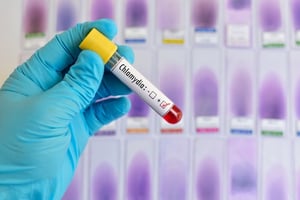Every year around 100 million people worldwide are infected with Chlamydia trachomatis, a sexually-transmitted bacterial infection that mainly affects women. In the majority of cases it causes minor upsets, but – if not recognized and treated – can cause serious problems, such as pelvic inflammatory disease (in young women), with the risk of sterility, or complications during pregnancy and childbirth (lung and eye infections in new-borns).
Until now, both the use of antibiotics (although effective) and tests to diagnose the infection have failed to decrease its incidence – on the contrary, it is becoming increasingly widespread (the majority of cases are asymptomatic and, thus, the number of people infected is probably more than the aforesaid 100 million a year).
According to some estimates, chlamydia is the most common sexually-transmitted infection in the world. However, a new vaccine (the first to be tested on humans – up to now the vaccines developed have not left the laboratory or gone beyond animal testing) promises to offer a new treatment, as is the case already with the papillomavirus, another sexually-transmitted infection, on the decline today thanks to the use of vaccines. The new drug against chlamydia, for now named only with the initials CTH522, has been developed by specialists in infectious diseases at Imperial College, London, and the Statens Serum Institut of Copenhagen (Denmark), with funding from the European Commission and the Innovation Fund Denmark. The results of the experiment have been published in the scientific journal The Lancet Infectious Diseases.
The vaccine, tested with very encouraging results on 35 healthy volunteers, was developed using a protein found in the external membrane of the Chlamydia trachomatis bacteria (which appeared to be able to stimulate a good immune response), with two “versions” of the formulation: one, in the form of liposomes (miniscule droplets of fat that penetrate tissue well); and the other, with the addition of aluminium salts, well-known for stimulating the reaction of our defence system. The women, all of whom (naturally) did not have chlamydia, were vaccinated – through injections into the arm and nasal sprays – with one of the two types of CTH522, or with a placebo, and at the end it emerged that the vaccine triggered a strong immune response in 100% of the women treated using both the formulations, whereas the placebo triggered no reaction. Furthermore, the liposomal formulation proved to be 5.6 times more effective than the other. Finally, the women did not appear to suffer any notable side effects. These were the responses that were hoped for, and even if there were only a few volunteers, the data means that the research can be taken to the next phase (called, in fact, phase 2), which will allow for the effectiveness of the vaccine to be directly assessed (in fact, it is not sufficient for a vaccine to bring about an immune response: this “mobilization” must then lead to concrete results against the bacteria). New experiments using the liposomal form will start in the next months.

